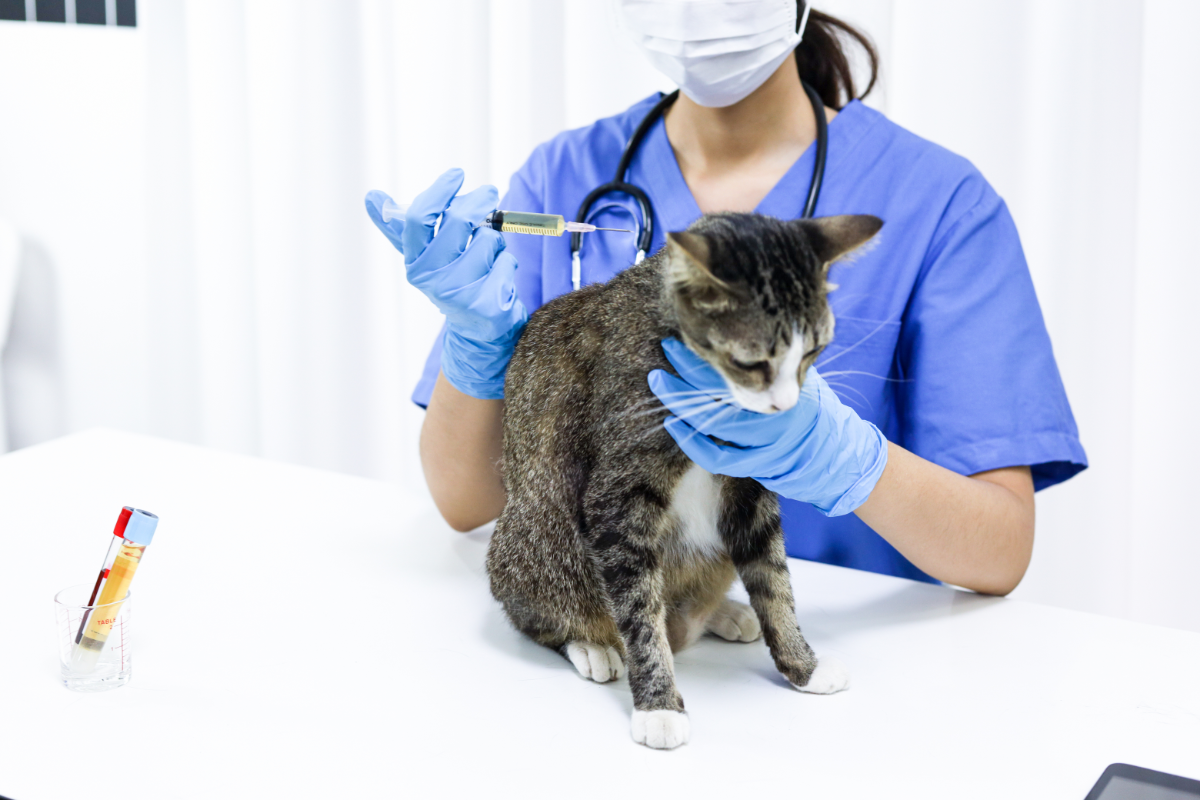Lymphoma in cats is a common cancerous disease that mainly affects the lymphatic system of our felines. The condition can cause a variety of symptoms, depending on where it develops in the body. For cat owners, it’s crucial to understand this disease so you can detect it early and explore the treatment options available.
What causes this disease?
Lymphoma in cats is a complex disease whose exact causes have yet to be elucidated. However, experts have identified several risk factors. Genetic factors play a key role, with some cats having a hereditary predisposition to lymphoma. This means that even without exposure to other triggers, these animals may be more likely to develop this form of cancer.
Environmental factors are also crucial. Exposure to toxic substances, such as pesticides, herbicides or even cigarette smoke, can increase the risk of developing lymphoma. In fact, studies show that cats living in homes where smoking takes place are more at risk, probably because of their habit of licking themselves, which leads them to ingest toxic substances.
Viral infections, particularly those caused by feline leukaemia virus (FeLV) and feline immunodeficiency virus (FIV), are strongly linked to the development of lymphoma in cats. These viruses weaken the immune system, making animals more vulnerable to cancer. Cats carrying these viruses have an increased risk of developing lymphoma, often at a young age in the case of those infected with FeLV.
Finally, a weakened immune system can make it easier for cancer cells to develop.Advanced age exacerbates this phenomenon, while certain breeds of cat have an increased susceptibility to developing the disease.
What are the symptoms of lymphoma in cats?
Symptoms of lymphoma vary considerably depending on the location of the cancer. One of the most common signs is swollen lymph nodes. These lymph nodes, located mainly in the neck, armpits and groin, can become swollen and are often easily palpated. This is often an early warning sign for owners and vets.
Weight loss is also common, even if the cat continues to eat normally. This weight loss is often accompanied by a reduced appetite, which can lead to a rapid deterioration in the animal’s physical condition.
Gastrointestinal problems such as vomiting and diarrhoea are common, particularly if the lymphoma affects the digestive system. These symptoms can lead to dehydration and further weaken the animal. In cases where the lymphoma affects the mediastinum (the area between the lungs), the cat may experience breathing difficulties, manifested by laboured breathing or breathing through the mouth.
Other symptoms include jaundice (if the liver is affected), polyuria and polydipsia (increased water consumption and frequency of urination), and general weakness. Each symptom is a potential indicator of the location and extent of the lymphoma, which underlines the importance of prompt veterinary consultation as soon as these signs appear.
How is the diagnosis made?
Diagnosis of lymphoma in cats requires a multifactorial approach. The process generally begins with a thorough clinical examination, where the vet looks for visible signs such as swollen lymph nodes or masses in the abdomen. This examination is crucial in guiding further investigations.
Blood tests are then carried out to assess the cat’s general health and look for abnormalities that could indicate lymphoma. These tests measure blood counts, blood biochemistry and other important parameters.
If lymphoma is suspected, a lymph node puncture or biopsy is often necessary. This test involves taking samples of cells from the swollen lymph nodes and examining them under a microscope. This confirms the presence of cancer cells. In some cases, a surgical biopsy may be recommended to obtain a more substantial tissue sample.
Medical imaging is also an essential diagnostic tool. X-rays, ultrasound scans or computer tomography (CT scans) can be used to locate tumours and determine the extent of the disease. These techniques allow the internal organs to be visualised and the impact of the lymphoma on the cat’s body to be assessed.
Finally, viral tests can be performed to check for the presence of FeLV or FIV, two viruses closely associated with lymphoma in cats. These tests are crucial in confirming or ruling out these infections as the underlying cause of the cancer. The final diagnosis is based on a combination of these tests and helps determine the best treatment plan.
What treatments are available?
Chemotherapy is the mainstay of treatment for lymphoma in cats, offering the most effective method of combating the disease. Chemotherapy uses anti-cancer drugs to target and destroy cancer cells, slowing the progression of the disease. The treatment protocol may vary depending on the type of lymphoma, the stage of the disease and the cat’s individual response.
Vets administer chemotherapy in different ways: intravenously, orally or subcutaneously. Potential side effects include bone marrow suppression, nausea, loss of appetite and general fatigue. However, the majority of cats tolerate this treatment well and are able to maintain a good quality of life during therapy.
The prognosis depends on many factors, including the type of lymphoma, the presence of FeLV or FIV, and the location of the cancer. Some cats may achieve temporary remission with chemotherapy, extending their lives by several months or years. It is important to discuss the prognosis and treatment options in detail with your vet to make informed decisions.
Which natural supplement should I use?
Natural alternatives offer complementary options for the treatment of lymphoma in cats, although their effectiveness often remains to be confirmed. Herbal medicine is one of the most common approaches, with some plants showing potential in veterinary oncology.
Milk thistle (Silybum marianum) is well known for its liver-protective properties. Its main component, silymarin, has been shown to have chemopreventive effects and may enhance the efficacy of certain chemotherapy treatments. However, it is important to watch out for potential drug interactions.
White mistletoe (Viscum album) is another plant used for its immunomodulatory properties and anti-cancer effects. However, there is still debate about the efficacy of white mistletoe in veterinary oncology, which limits its use in France.
Linoleic acid, found in safflower oil , has shown positive effects in the treatment of cutaneous lymphoma in dogs, but requires high doses, which can pose practical challenges.
Aloe vera sometimes improves the quality of life of animals with cancer, despite limited scientific evidence of its anti-cancer efficacy. It is frequently used to manage the side effects of radiotherapy.
Finally, cannabidiol (CBD), extracted from hemp, is attracting growing interest for its anti-inflammatory and anti-tumour properties. Although studies in cats are still rare, CBD could offer a complementary option for relieving pain and improving quality of life.
It is crucial to discuss any natural treatment options with a vet before incorporating them into your cat’s care plan, as some of these alternatives may interact with conventional treatments or present health risks for the animal.
What are the means of prevention?
Although there is no sure way of preventing lymphoma in cats, certain measures can reduce the risk of developing the disease. Keeping your cat indoors is one of the most effective strategies for limiting its exposure to pathogens, particularly FeLV and FIV.
Early detection of FeLV and FIV infections is crucial, especially in kittens or new cats brought into a household. When a cat tests positive, apply extra precautions immediately to prevent the spread of the viruses.
Vaccinate against FeLV too, especially for cats that go outdoors. Although there is no vaccine against FIV, protecting your cat against FeLV can reduce its risk of developing lymphoma.
Avoiding exposure to cigarette smoke is another important measure. Passive smoking is a known risk factor for cancers in animals, including lymphoma. A smoke-free environment is therefore essential for your cat’s health.
Finally, taking your cat to the vet regularly for routine check-ups and blood tests means that any abnormalities can be detected quickly and early action taken if necessary. These regular visits are particularly important for cats over 7 years of age, as they are more likely to develop serious illnesses.





